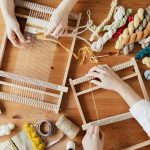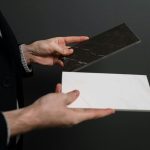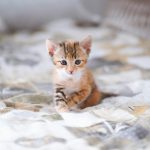You should expect to pay between $2 and $10 per yard for calico fabric, depending on quality and design complexity. Plain calico with a basic weave tends to be cheaper, while higher thread counts, long-staple cotton, and detailed prints raise the price. Where you buy also matters—online shops often offer better deals, but local stores let you check fabric feel and color. Keep going to discover how to find the best value and make smart purchases.
Table of Contents
Key Takeaways
- Calico fabric prices vary based on quality, print complexity, and production location, typically ranging from budget to premium levels.
- Higher thread counts, long-staple cotton, and finishing processes increase calico fabric costs due to enhanced durability and softness.
- Simple patterns like basic stripes cost less, while intricate or custom prints raise the price significantly.
- Buying larger quantities or during sales can reduce the price per yard for calico fabric.
- Online stores generally offer lower prices and wider selection, but factor in shipping fees compared to potentially higher-priced in-store purchases.
What Is Calico Fabric and Why Is It Popular?
Calico fabric is a simple, plain-woven cotton material that’s known for its durability and affordability. When you choose calico, you’re picking a fabric that’s versatile enough for everything from quilting to home décor.
Its natural cotton fibers make it breathable and comfortable, perfect for clothing and crafts alike. You’ll find calico easy to work with because it holds dye well, giving you vibrant colors and patterns.
Plus, its sturdy weave means it won’t easily tear or wear out, making your projects last longer. Whether you’re a beginner or an experienced sewer, calico offers a reliable, budget-friendly option without sacrificing quality or feel.
That’s why it’s become a popular choice for so many creative uses.
Factors That Affect the Price of Calico Fabric
When you shop for calico fabric, you’ll notice prices vary based on quality differences, print complexity, and where the fabric is made.
Higher-quality fibers and intricate designs usually cost more.
Plus, fabrics produced in certain locations might carry a higher price tag due to labor and material costs.
Fabric Quality Variations
Although you might think all calico fabrics are the same, several quality factors directly influence their price. When you shop, pay attention to the thread count — higher thread counts usually mean a tighter weave and a smoother, more durable fabric, which costs more.
The type of cotton used also matters; long-staple cotton fibers produce softer, stronger calico, driving the price up. Additionally, the finishing process impacts quality and price. Fabrics that have been mercerized or pre-shrunk often come at a premium because they offer better color retention and less shrinkage after washing.
If you want calico that feels soft and lasts longer, be ready to invest a bit more for these quality variations rather than settling for basic, lower-grade options.
Print and Design Complexity
Beyond the fabric’s quality, the complexity of the print and design plays a big role in determining the price. When you choose calico with simple patterns, like basic stripes or dots, it tends to be more affordable. However, intricate designs with detailed motifs or multiple colors require advanced printing techniques, pushing the cost higher. Custom or limited-edition prints usually come at a premium, too.
| Print Type | Complexity Level | Typical Price Range (per yard) |
|---|---|---|
| Basic Patterns | Low | $3 – $6 |
| Multicolor Prints | Medium | $6 – $10 |
| Custom/Artisan | High | $10 – $20+ |
Understanding this helps you balance your budget with the style you want for your project.
Source and Production Location
Since the source and production location of calico fabric greatly influence its price, you should consider where and how the fabric is made.
Fabrics produced in countries with higher labor costs, like the US or Europe, usually come at a premium. In contrast, calico from regions with lower production expenses, such as India or Pakistan, tends to be more affordable.
Additionally, locally sourced cotton and traditional manufacturing methods may increase costs but often result in higher quality. If you prioritize ethical production, fair wages, and sustainable practices, expect to pay more.
Conversely, mass-produced calico from large factories usually costs less but might sacrifice quality. Understanding these factors helps you make informed choices and find calico fabric that fits your budget and values.
Typical Price Range for Plain Calico Fabric
When shopping for plain calico fabric, you’ll typically find prices ranging from $5 to $15 per yard, depending on factors like quality, thread count, and supplier.
Lower-priced calico usually features a lighter weight and a lower thread count, making it suitable for crafts or basic projects. Higher-end options with denser weaves and finer cotton offer more durability and a smoother finish, ideal for apparel or detailed sewing.
Bulk purchases or wholesale orders can also lower the cost per yard. Keep in mind that organic or specialty-calico fabrics may push prices toward the higher end of this range.
How Printed Calico Fabric Pricing Differs
When you choose printed calico fabric, the design’s complexity can raise the price considerably.
Higher-quality prints with vibrant colors and fine details usually cost more than simpler patterns.
Understanding these factors helps you pick the right fabric within your budget.
Design Complexity Impact
Although calico fabric is generally affordable, the price can vary considerably depending on the complexity of the printed design.
When you choose simple patterns, like basic shapes or single-color prints, you’ll usually pay less. More intricate designs with multiple colors, detailed motifs, or overlapping elements require advanced printing techniques, which increase production costs.
If your project demands fine lines, shading, or custom artwork, expect the price to rise accordingly. Complex patterns also take longer to produce, adding to the expense.
Print Quality Variations
Since print quality directly affects the look and feel of calico fabric, it also plays a major role in pricing. When you choose high-resolution prints with sharp details and vibrant colors, expect to pay more.
Cheaper prints often use basic techniques that result in faded or uneven colors, which lowers the cost. Digital printing offers excellent precision but can be pricier than traditional screen printing, especially for small batches.
Additionally, fabrics printed with multiple color layers or special finishes like metallic inks increase the price. If you want your calico to stand out with crisp, vivid patterns, investing in superior print quality is essential.
Ultimately, the better the print quality, the higher the cost, but you get fabric that looks professional and lasts longer.
Where to Buy Calico Fabric at the Best Prices
Wondering where you can find calico fabric without breaking the bank? Start by checking online marketplaces like Etsy and Amazon, where sellers often offer competitive prices and bulk discounts.
Fabric specialty stores, both online and local, also carry calico, sometimes providing seasonal sales or clearance deals. Don’t overlook large craft retailers; they frequently run promotions that make buying in-store or online cost-effective.
If you want even better rates, explore wholesale fabric suppliers, especially if you need larger quantities. Thrift stores and fabric swaps can be unexpected goldmines for affordable calico.
Keep in mind that prices can vary based on print quality and fabric weight, so compare options carefully to find the best balance between cost and quality for your project.
Tips for Getting the Most Value When Purchasing Calico
How can you guarantee you get the best value when purchasing calico fabric? First, always check the fabric’s weight and thread count—higher numbers usually mean better quality.
Don’t hesitate to ask for samples so you can feel the texture and assess durability before buying in bulk. Buying in larger quantities often lowers the price per yard, but only if you’re sure you’ll use it all.
Keep an eye out for sales or clearance events at fabric stores. Also, consider the fabric’s finish and colorfastness; ensuring it holds up after washing saves you money long-term.
Finally, read reviews or get recommendations from fellow sewists to avoid low-quality calico that might cost you more in the end.
Comparing Calico Fabric Prices Online vs. In-Store
When you’re looking to get the best value on calico fabric, deciding where to shop plays a big role.
Online stores often offer lower prices due to reduced overhead costs, plus you can easily compare multiple sellers to find the best deal. You also benefit from customer reviews and detailed product descriptions that help guarantee quality.
Online shops offer lower prices, easy comparisons, and customer reviews to ensure quality purchases.
On the other hand, buying in-store lets you feel the fabric’s texture, check its weight, and see colors more accurately before purchasing. However, physical stores sometimes charge more due to rent and staff expenses.
To get the best price, consider starting online to research options and then visit a local shop if you want to verify quality or avoid shipping fees. This balanced approach helps you save money without sacrificing assurance.
Frequently Asked Questions
How Do I Care for and Wash Calico Fabric?
To tenderly treat your trusty calico, toss it in cold water, use mild soap, and skip the scorching dryer. This careful cleaning curbs color fading, keeps the fabric fresh, and guarantees your calico stays charmingly cozy.
Is Calico Fabric Suitable for Upholstery Projects?
You can use calico fabric for upholstery, but keep in mind it’s lightweight and not as durable as heavier fabrics. It’s best for decorative pieces or light-use furniture rather than everyday, high-traffic seating.
Can Calico Fabric Be Dyed or Customized Easily?
Did you know 90% of DIY crafters prefer calico for dyeing? You’ll find calico fabric takes dye easily, letting you customize colors and patterns effortlessly for unique, personalized projects. It’s a great choice for creativity!
What Are the Environmental Impacts of Producing Calico Fabric?
You’ll find that producing calico fabric impacts the environment through water use, pesticide application, and energy consumption. Choosing organic or sustainably sourced calico can help reduce these effects and support eco-friendly practices.
How Does Calico Fabric Compare to Other Cotton Fabrics?
You’ll find calico fabric is coarser and less refined than other cotton fabrics like muslin or poplin. It’s more affordable and versatile, but it lacks the smoothness and sheen of higher-end cotton materials.
- Does Chiffon Fabric Stink - July 15, 2025
- Does Chiffon Fabric Affect the Economy - July 15, 2025
- Does Cotton Fabric Have a Nap - July 15, 2025







